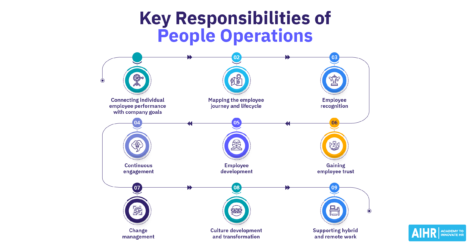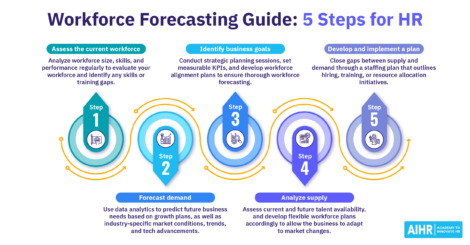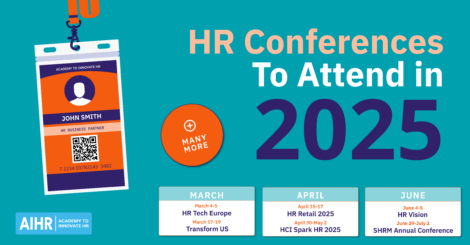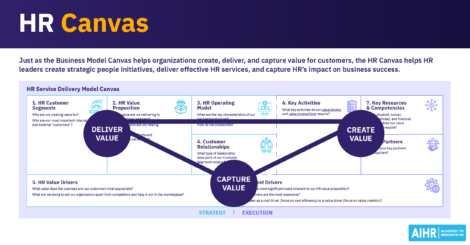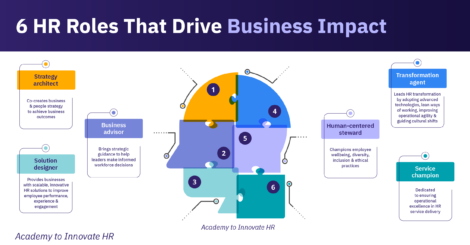13 HR Technology Trends To Watch in 2025
HR technology is transforming workplaces. In fact, the global HR tech market is set to grow from $40.45 billion in 2024 to $81.84 billion by 2032.
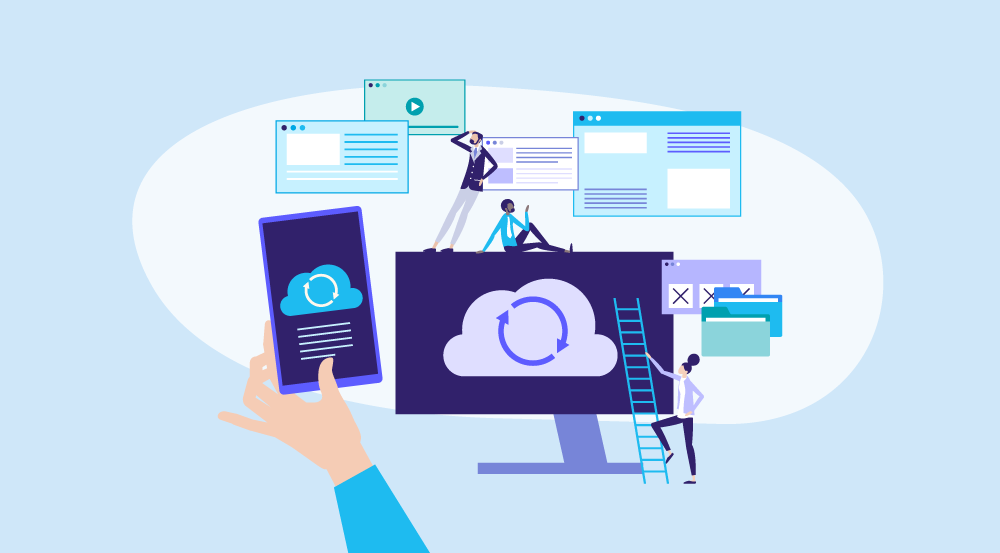
Employers in the U.S. alone have invested over $5 trillion in HR technology, and 74% of companies plan to increase their HR tech budgets. Additionally, 80% of companies on Forbes’ Global 2,000 list will use algorithmic managers for hiring, firing, and training employees.
The ability to use HR tech is clearly an integral part of a career in HR, so it’s important to keep up with the latest trends. This article discusses the advantages of human resources technology and the top 13 HR tech trends to watch in 2025.
Contents
What is HR technology?
The benefits of HR technology
13 HR technology trends to watch in 2025
The benefits of HR technology
Technology in HR has been instrumental in enabling efficiency and data-driven decision-making. It also integrates with the broader shift toward digital transformation in businesses worldwide.
When properly executed, it generally positively impacts HR, employees, and organizations as a whole. Its benefits include:
- Addressing challenges: HR tech solutions can help address challenges like time-intensive manual processes, scalability issues, and improving the employee experience.
- For HR professionals: HR technology can enable greater efficiency and help improve HR decision-making through data analytics. This can also lead to higher employee satisfaction.
- For employees: Combining HR and technology can help create a better employee experience. For instance, employees may have more autonomy to do certain tasks and opportunities for learning and development.
13 HR technology trends
Trend 1: AI and machine learning in recruitment
Artificial intelligence (AI) and machine learning (ML) are revolutionizing recruitment by automating repetitive tasks, improving decision-making, and enhancing candidate experiences. These technologies address common inefficiencies and biases in traditional hiring methods, making them highly important to HR teams today.
Key applications
- Résumé screening: Tools like HireVue use AI to filter resumes quickly based on skills and qualifications.
- Reducing bias: AI focuses on candidate skills and experience, promoting diversity by ignoring demographic factors.
- Predictive analytics: Platforms like Workday analyze data to predict candidate success and retention.
- Chatbots: Tools like Olivia by Paradox handle tasks like answering FAQs and scheduling interviews.
Example in practice
Unilever’s adoption of AI in recruitment involves using Pymetrics to evaluate candidates through neuroscience-based games and HireVue for AI-analyzed video interviews. The company uses AI for résumé screening and video interviews, cutting hiring time by over 50,000 hours and boosting diversity.
Trend 2: More personalized HR self-service
Employee self-service portals have two main benefits: employees can be in charge of their data and information, and HR teams can shift their focus from administrative tasks to strategic initiatives.
HR self-service has become better aligned with individual preferences through technology such as AI. A good example of this is the experience-driven HR service model, which allows HR to balance efficiency, cost, technology, and employee engagement to deliver HR services.
Key applications
- Personalized dashboards: Employees can view tailored content like performance goals, benefits, and learning opportunities in one place.
- Custom benefits management: This includes tools that let employees explore, compare, and choose benefits packages based on their preferences and eligibility.
- AI-powered chatbots: Virtual assistants that provide instant answers to HR-related queries, such as leave balances or payroll issues, without human intervention.
- Learning recommendations: Platforms can suggest personalized training and development opportunities based on career aspirations and past activities.
Example in practice
Walmart’s One Walmart portal allows its large, diverse workforce to manage their work schedules, payroll, and benefits. Employees can also access training videos, the latest company updates (e.g., quarterly earnings), and career support resources on the platform.
Trend 3: A focus on employee experience platforms
An employee experience platform (EXP) centralizes and streamlines the interactions between organizations and their employees throughout the employee life cycle. Employees can find all the resources they need on an EXP, access training, manage daily tasks, and more.
A frontline employee experience platform (FEXP) does the same, but specifically for frontline workers in retail and hospitality. With over 80% of the global workforce consisting of frontline workers, an increased focus on FEXP solutions is likely in 2025.
Key applications
- Centralized communication hubs: Employees access company updates, news, and announcements in one place, ensuring alignment and transparency.
- Integrated learning tools: EXPs offer on-demand training, certifications, and career development resources tailored to individual goals.
- Feedback mechanisms: Employees can provide input and share concerns through integrated surveys and feedback tools, enabling continuous improvement.
- Wellness and support features: Tools for mental health resources, wellness programs, and access to benefits that prioritize employee well-being.
Example in practice
Toyota uses a FEXP called Firstup, which is branded One Toyota. More than 80,000 employees are registered on the platform and use it for practical purposes, such as accessing their payslips, checking their schedules, or engaging with cultural company initiatives.
HR’s top burning question
Will HR technology replace HR professionals or teams?
AIHR’s Chief Scientist (HR & OD), Dr Dieter Veldsman, says: “HR technologies will inevitably replace some tasks and activities traditionally performed by HR professionals—and this should be seen as a positive evolution. Rather than viewing these advancements as a threat, HR professionals should recognize technology as an enabler, freeing them to focus their time, effort, and expertise on high-impact work that demands a human touch.
Far from replacing HR professionals, these technologies will augment their capabilities, empowering them to achieve more. To thrive in this landscape, HR professionals must embrace technology and learn to maximize its potential. By doing so, they can amplify their impact, extend their influence, and solidify their role as strategic partners to the business.”
Trend 4: Predictive analytics becoming more commonplace
Predictive analytics in HR uses data-driven algorithms to anticipate workforce trends, optimize decision-making, and proactively address potential challenges. These tools empower organizations to avoid issues like turnover, skill gaps, and engagement dips.
Key applications
- Turnover prediction: Algorithms can analyze historical data to help identify employees at risk of leaving, enabling targeted retention efforts.
- Workforce planning: Trends in company growth, market conditions, and employee performance data allow you to predict future hiring needs
- Skills gap analysis: This helps you to forecast skills your organization will need in the future and design upskilling programs to bridge these gaps.
- Engagement forecasting: You can use this to analyze employee engagement patterns to predict dips in engagement and implement strategies to maintain morale.
Example in practice
Cisco uses predictive analytics to determine its workforce planning approach, which helps it proactively fill skills gaps and anticipate future needs. Its people leaders use internal HR and external market data to project skills needs and improve performance management.
Learn the skills you need to maximize HR technology’s potential
The ability to effectively harness HR technology requires you to analyze data, streamline processes, ensure user adoption, and align it with organizational goals.
In AIHR’s Digital HR 2.0 Certificate Program, you will learn how to implement digital projects, minimize resistance to change, and drive digital adoption.
Trend 5: Further integration of collaboration tools solutions
Integrating collaboration tools with HR systems enhances workplace connectivity, streamlining communication, project management, and employee engagement. These solutions bridge the gap between operational tasks and HR functionalities, creating a more unified work environment.
Key applications
- Seamless communication: Collaboration tools like Slack, Teams, or Zoom integrate with HR platforms to allow employees to connect effortlessly and access HR resources without leaving their primary workspace.
- Task management integration: Linking tools like Asana or Trello with HR systems ensures smoother project delegation and tracking, aligned with employee performance and objectives.
- Onboarding and training: Integrations with collaboration tools allow new hires to complete onboarding tasks and access training modules, enhancing their experience.
- Recognition and feedback: Integrated features for shout-outs, recognition, and feedback make it easy to acknowledge achievements and provide real-time input.
Example in practice
Upflex uses Google Workspace because it offers teams instant, real-time collaboration. This allows them to collaborate on documents, workspaces, and calendars without needing to deal with complicated access permissions or send email attachments.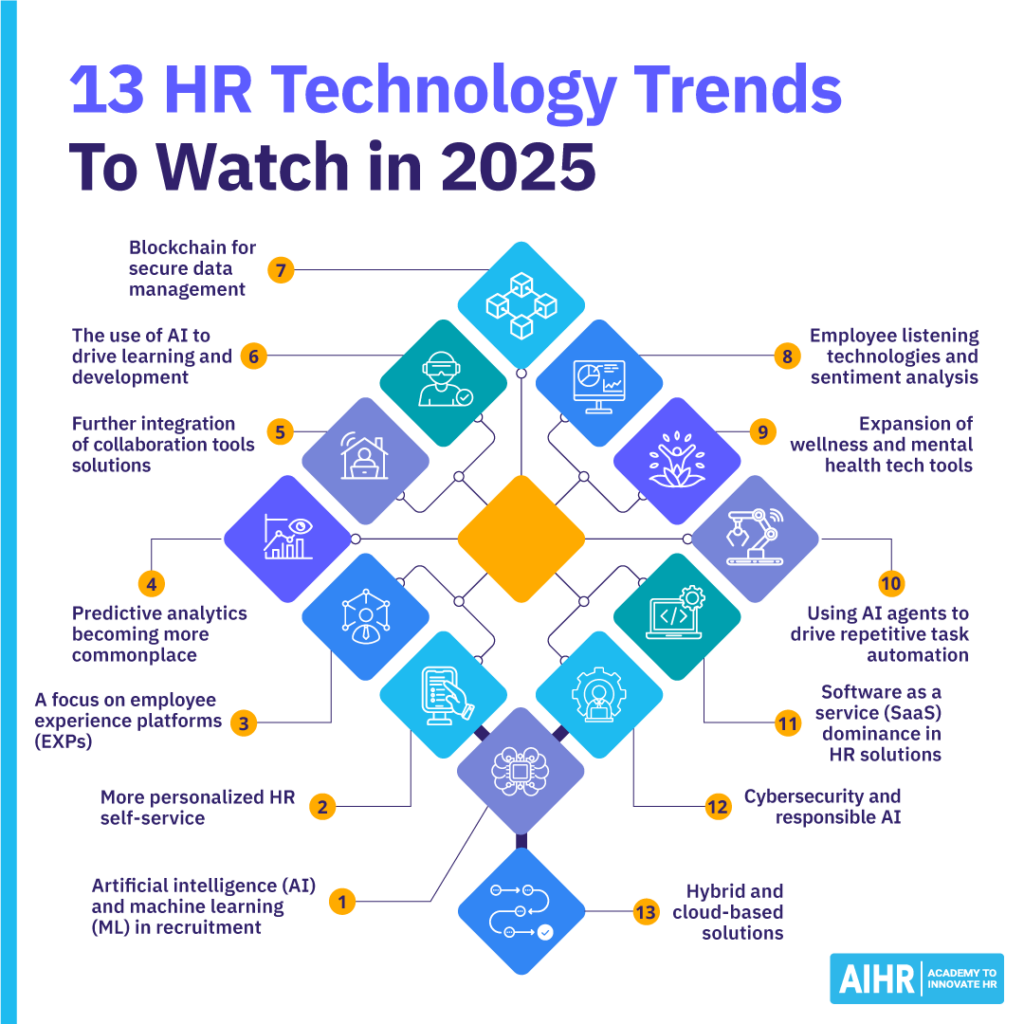
Trend 6: The use of AI to drive learning and development
AI in learning and development already has many applications, as the Learning and Development function has pioneered the adoption of AI in HR. Examples include providing learning recommendations, improving analytical insights, and curating content. AI will play an even bigger role in changing the employee learning experience in the next few years.
Key applications
- Accessibility: Generative AI advances have made learning more accessible to all employees, converting texts into Braille for sight-impaired learners and transcribing audio and video content into text for hearing-impaired learners.
- Coaching: AI can act as a learning coach, providing suggestions and real-time feedback to learners. Wondder, for example, uses virtual reality (VR) and AI to give input on scenarios like DEIB situations and performance discussions.
- Personalization: AI can use various data sources (e.g., learner interests, career goals, assessment data, etc.) to suggest personalized learning.
Example in practice
LinkedIn Learning has introduced an AI-powered coaching system in the form of a chatbot. It allows its users to ask for guidance on specific business questions. The chatbot acts as a coach and guides members through their learning journey, recommends learning content based on the user’s job and situation, and answers specific questions.
Trend 7: Blockchain for secure data management
Blockchain technology can greatly improve data security and integrity, streamline HR processes, and increase compliance with regulatory requirements. Additionally, it offers interesting benefits for employee data management, such as enhanced security, transparent and auditable records, and data privacy and consent.
Key applications
- Certification and credentialing: Blockchain enables a secure verification and storage of training records, employee credentials, and certifications.
- Identity verification: Blockchain-based identity verification technology allows your organization to ensure secure verification of employee identity and qualifications.
- Recruitment and hiring: Blockchain-based technology can also conduct background checks, verify candidate credentials, and record employment history, creating a transparent and secure process.
Example in practice
The Estonian government has implemented a blockchain-based solution called X-Road to manage employee data and provide secure access to government services. X-Road acts as a decentralized data exchange layer, allowing different institutions to efficiently access and share employee records without compromising privacy.
Trend 8: Employee listening technologies and sentiment analysis
Employee listening technologies help organizations gather feedback, assess employee morale, and identify concerns through tools like surveys, pulse checks, and sentiment analysis. These systems use data analytics and AI to interpret employee feedback, offering insights that improve workplace culture and engagement.
Key applications
- Pulse surveys: These short, frequent surveys capture employee feedback on specific topics, allowing you to act quickly on issues like work-life balance and team morale.
- Sentiment analysis: AI-powered tools can help you analyze the language used in employee feedback, emails, or chats to gauge emotional trends and attitudes.
- Engagement metrics: Real-time dashboards can measure engagement levels based on responses to feedback tools, offering HR and leadership actionable insights.
- Crisis management: Through sentiment monitoring, you can detect early signs of discontent or burnout, enabling proactive intervention from HR and managers.
Example in practice
Qualtrics offers employee listening solutions through EmployeeXM, which incorporates AI-driven sentiment analysis. Qualtrics’ tools enable the analysis of open-ended survey responses, supporting the understanding of employee sentiment beyond numerical ratings.
Trend 9: Expansion of wellness and mental health tech tools
Organizations increasingly adopt wellness and mental health tech tools to support employee wellbeing. These solutions address physical health, mental resilience, and stress management to ensure a healthier and more productive workforce.
Key applications
- Integrated digital wellness platforms: Such platforms can consolidate all the organization’s wellness tools for employees in one place (e.g., nutrition guidance, meditation apps, fitness trackers, and mental health check-ins).
- Personalization: The use of AI and data analytics can allow your company to offer employees tailored mental health programs to address their specific individual needs.
- Employee assistance programs (EAPs): Digital EAPs provide can counseling, financial advice, and stress management resources through secure apps.
Example in practice
Enterprise software and services company CoEnterprise uses the holistic wellness platform Wellable for its wellness initiatives. Its main purpose is to drive active employee participation and foster a culture of health amongst its fully remote workforce.
Trend 10: Using AI agents to drive repetitive task automation
More companies are using AI agents to automate repetitive and time-consuming HR tasks, freeing up HR teams to focus on strategic initiatives. These agents use machine learning (ML) and natural language processing (NLP) to handle tasks efficiently and accurately.
Key applications
- Recruitment automation: AI agents can screen résumés, schedule interviews, and send follow-up communications, reducing manual hiring efforts.
- Succession planning: AI agents can identify high-potential employees and create development plans for future leadership roles in the organization.
- Onboarding: During onboarding, AI agents can streamline document collection, task tracking, and orientation scheduling, creating a seamless onboarding experience for new hires.
Example in practice
IBM Watson uses an AI agent to uncover workforce trends, analyze employee data, and identify developmental needs. Through personalized recommendations, the tool enables the company’s HR team to make data-driven decisions about training and hiring.
Trend 11: SaaS dominance in HR solutions
SaaS (Software as a Service) has become the dominant model for HR software solutions. In fact, according to LinkedIn, the HR SaaS market is currently valued at $20 billion and is expected to grow at a 9.8% compound annual growth rate (CAGR) between 2024 and 2031.
Key applications
- Simplicity, scalability, and flexibility: SaaS solutions are cloud-based, so companies don’t have to invest in expensive hardware. They are also scalable and flexible, so they can easily adjust to changing business needs.
- Regular, automated updates: SaaS vendors can provide maintenance and system upgrades remotely, simplifying the organization’s IT management.
- Easy integrations: HR SaaS vendors also integrate with third-party solutions companies may use for benefits, recruitment, payroll, and other HR functions. Ensuring core HR data are consolidated in one place.
Example in practice
BambooHR simplifies recruiting, onboarding, and record-keeping with its cloud-based SaaS platform. It automates job postings, and candidate tracking, while its onboarding tools handle paperwork and training digitally. It stores employee data on a secure central database, simplifying access to profiles and compliance records, and improving efficiency.
HR tip
When buying HR technology and building your HR tech stack, ensure the new tool(s) can integrate easily with the ones you already use. If not, ask the vendor if they can build a custom integration system for you because a set of tools that can’t communicate with one another will be counterproductive.
Trend 12: Cybersecurity and responsible AI
As HR systems become more data-driven, it’s critical to safeguard sensitive employee data and ensure ethical AI-driven decisions. Cybersecurity measures and responsible AI practices help organizations protect data and build employee trust.
Key applications
- Data encryption: This helps secure sensitive employee information—such as payroll and personal particulars—to prevent breaches.
- Bias detection: AI systems can identify and mitigate biases in hiring and promotions, ensuring fair outcomes in recruitment, hiring, and talent management.
- Access controls: Role-based access ensures only authorized personnel can view sensitive data, reducing risk and unwanted exposure.
- Incident response: You can use tools that monitor and quickly respond to cybersecurity threats targeting HR systems, preventing or minimizing any attack’s impact.
Example in practice
Microsoft Azure provides secure cloud-based HR solutions with advanced encryption, access control, and AI bias detection. The platform protects sensitive employee data through robust encryption and multifactor authentication. It also supports integration with HRIS, enabling seamless access to analytics, recruitment, and performance management tools.
Trend 13: Hybrid and cloud-based solutions
Hybrid and cloud-based HR solutions enable companies to access critical HR functions from anywhere, supporting a mix of in-office and remote work. These platforms provide flexibility and scalability to meet the needs of modern workforces.
Key applications
- Cloud-based payroll: This can help you streamline salary processing and tax compliance, with secure remote accessibility to make the process more convenient and efficient.
- Employee portals: These self-service platforms allow employees to manage their data, benefits, and schedules from any location.
- Learning management systems (LMS): LMSs are cloud-hosted training programs offering on-demand skill-building for hybrid teams.
- Collaboration tools: These tools facilitate integrations that support communication and project management among distributed teams.
Example in practice
Workday’s cloud-based HR platform supports payroll, talent management, and analytics. It automates payroll processes, supports recruitment and performance management, and provides real-time workforce insights, helping organizations streamline operations and make data-driven decisions.
Having a defined HR technology strategy, architecture, and roadmap is crucial for long-term success. Falling into the trap of never maturing our technology stack leads to a lot of unused functionality, low adoption, and a lack of ROI. Having a solid strategy and roadmap is the first step in ensuring you can maximize the potential of HR technology.

To sum up
Trends like AI, blockchain, and predictive analytics are transforming how businesses enhance efficiency, engage employees, and solve challenges. Adopting the right tools can help you streamline operations and create a better employee experience.
To future-proof your HR strategy, focus on secure, scalable, and user-friendly tech that supports collaboration, wellbeing, and data-driven decisions. The right HR technology can not only make your job easier and more efficient, but it can also help you enable both organizational success and employee satisfaction.
Learn more
Related articles
Are you ready for the future of HR?
Learn modern and relevant HR skills, online







